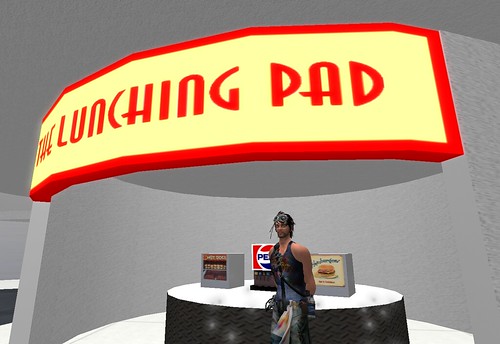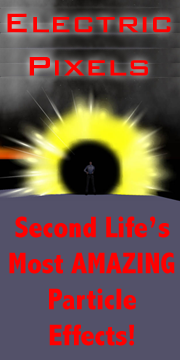From time to time I interview those who do interesting business ventures, and today's interview is with very ingenious and talented Fianna Idora.
Second Effects: How and when did you get started in SL?
Fianna Idora: I joined SL in October 2006. I was working full time as a web-based application developer and was also combining my technical skill with a love for art into a part-time graphic t-shirt business online. A friend of mine had posted a link to Second Life on a business community forum I frequented, as a possible new venue for our online marketing efforts. Second Life was getting a lot of press back then, as it was nearing the 1 Million Residents mark. It soon became apparent that SL would also appeal to one of my other interests - 3D content creation, as I had been a recently active 3D hobbyist in the Poser community. Teaching myself digital rendering, character creation & 3D Texturing. I was hooked to say the the least. I went premium within 24-hours of signing up and was sticking my virtual stake in my first 512m plot within a week. The first incarnation of my shop was called Fairy T-shirts, where I sold SL versions of my FL t-shirt designs along with notecards containing urls to where the shirts could be purchased in FL.
SE: What skills did you bring into SL that helped you get your business started?
FI: Between my work as a web-based application developer, operating online graphic t-shirt business and being a 3D hobbyist - I came in with a pretty mixed bag. The income previously earned from my t-shirt biz had already afforded me to purchase software including Photoshop (images/textures), Poser (animations/poses), and later ZBrush (textures, sculpties), so I had a great software foundation to cover the bases of content creation.
My programming skills translated fairly well when learning LSL - although my primary focus in SL wasn't scripting, I was more interested in texturing and generally only scripted things on an as-needed basis to enhance a product or create a tool to make my Second Life easier. It wasn't until later when I realized that using LSL I could interact with external databases hosted on the web, that I truly began thinking outside the grid.
When I first arrived in SL I would have considered myself to be an adept user of Adobe Photoshop. However, After attending the
'Masters Fashion Design' program in-world at Soma School of Design, I'd say my knowledge and skill level increased 10-fold. SL became major creative outlet for me - so much so I wanted to pursue a design career full time. Last year I left the company I had been with for 7 years to return to college to Study Graphic Design - I'll be graduating from the two year program this coming May.
SE: You have been known to operate a fashion business - how is that going?
FI: My shop Enchant3D has been located on the mainland in Han Loso since January 2007. Its more of a costume shop than a fashion boutique, and really its just a hodge podge of whatever i felt like making at the time. I've tried my hand at animation, clothing, jewelry, props, roleplay costumes & skins with various degrees of success. At the moment I have about 100 items listed on xstreet - the accumulation of my content creation for the last 3 years. Between xstreet and inworld sales Enchant3D *just* makes my tier each month (for 1/8 of a sim), so I am able to maintain it despite being a full time student for the last two years and not having a regular source of FL income. However, I've been considering closing the shop in-world after 3 years of operation, eliminating the majority of my tier fees and focusing on making xstreet sales, marketing my products online with the hopes that I can make the business profitable.
SE: I understand you have two avatars - why do you operate two of them?
FI: I'm a bit of a geek girl and originally created Light Bright, as an alternative character for my cyberpunk inspired photography, role-play and story-telling. In Late 2007 I began planning the Profile Picks project and since Light is my nodal thinker, it made sense that I give her an information project to manage. Using my alt for this project allowed me to script & work for hours without interruption. Light also functions as an accountant for this project allowing me to support my customers & track sales easily without intermixing with my day-to-day SL activities.
SE: I've been trying out your new product, "Profile Picks". How does profile picks work? What problem does it solve for businesses? For customers?
FI: One of my areas of specialization is the development of
search engine marketing and search engine optimization strategies for the world wide web. In November 2007, Linden Labs unveiled their new Search (
http://search.secondlife.com) which is built on the Google Search Appliance. The same strategies I had adopted for Google and the WWW now applied directly to the Second Life Search.
One of the foundations of how a Google ranks a web page in its results for a particular search phrase, is by determining its relevance, based on the number of inbound links it has from other web site pages with related keyword content. In theory, the more relevant inbound links a page has, the higher it should rank in results for that search phrase.
Second Life Places and Resident Profiles are now available as web pages in-world and on the world wide web if flagged to be included in the Search index. If you view a Resident's profile page under "Top Picks" you'll see that a resident's profile picks have been linked to their corresponding Place pages creating an inbound link to that location. The content of the Picks descriptions providing the relevant key phrases for that inbound link. Thus, the number of inbound picks received, and the key phrases used in their descriptions, play a key role in determining how your Second Life Place will rank for those phrases.
i.e.
Light Bright Resident Page
http://world.secondlife.com/resident/e597f8dc-798f-47f1-b705-a3dd874bcb4f
Profile Picks Place Page
http://world.secondlife.com/place/5bce8fcf-275b-cc41-6b0d-36b6dca83b95
The primary goal of Profile Picks is to educate business owners on the the importance of creating a Profile Picks Incentive Program (PPIP) as a key part of your marketing strategy. Members can also access our Learning Library containing regularly updated articles regarding the Second Life Search and best practices for optimizing parcels & profile pages for relevant key word phrases.
The first product developed is the Profile Picks Gift Vendor now at version 1.3 - this vendor will deliver a gift to any account-verified resident who has your Second Life place in their Profile Picks. This type of Profile Pick Incentive Program can be operated with minimal costs, helping you to increase your rank in search while at the same time creating customer loyalty and exposing more potential customers to your products or services.
SE: Why is Profile Picks better than the competition (is there competition?)
FI: There are a few other products on the market that assist residents to develop Profile Pick incentive programs. However I feel Profile Picks has a few value added benefits including our online reporting which allows you to monitor gifts delivered, and the total number of gifts resident has received, from anywhere online. There are anti-abuse measures in place allowing you to ban a resident you feel may be attempting to abuse the system. Members also receive access to articles I've put together with information regarding search and optimizing your Second Life place. Customer Relationship Management is also important to me and I encourage customers to contact me with any questions or suggestions.
SE: What barriers to business success have you encountered, and do you have suggestions for new business owners to overcome them?
FI: I think one of the problems I've experienced with Enchant3D is that my range of products is too broad. I've tried to learn a bit everything instead of focusing on becoming really good at one thing in particular. I've learned that businesses that are a focused on creating a specific type of product or service, in addition to achieving higher quality, stand to do better from a optimization perspective and are easier to market. My main roadblock this far has been time. I believe that success could be achieved with a full time effort, but between work and school I haven't been able to make that kind of commitment to SL. The SL economy hasn't proven stable enough that I would rest the needs of my home & family on it just yet.
SE: What might be your future plans for your businesses? Where do you see yourself in three years?
FI: When I graduate from college next year I will likely be working from home as a freelance graphic & web-based application designer. I'm hoping to return my focus to my graphic t-shirt business perhaps with its own expanded presence in SL. I also hope to continue to work and refine my skills as a content creator when I am able to return to SL with a fresh outlook and more freedom to grow the Enchant3D brand. Meanwhile, I am committed to expanding Profile Picks program, expanding the Learning Library and improving the products and services available. No matter what happens, I can't see myself not having some kind of presence in SL going forward, whether my focus is on content creation or using SL as a tool for promoting my FL products & services.
SE: Thank you so much for speaking with us today!
For those of you who'd like to see more of Fianna's work, please try these URLs:
http://www.enchant3d.com
http://www.profilepicks.com
http://www.popularitees.com













![Reblog this post [with Zemanta]](http://img.zemanta.com/reblog_e.png?x-id=9d6f89ec-7d1a-4665-bded-298efcc6153d)

![Reblog this post [with Zemanta]](http://img.zemanta.com/reblog_e.png?x-id=b410d356-f225-4c77-97a6-96a9cd924d95)


![Reblog this post [with Zemanta]](http://img.zemanta.com/reblog_e.png?x-id=b9a8eaad-460a-4498-9eb0-7c30c1f854e5)

































 virtual business, building virtual products and exploring the virtual world.
virtual business, building virtual products and exploring the virtual world.